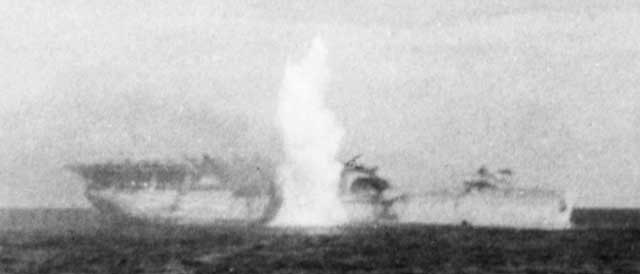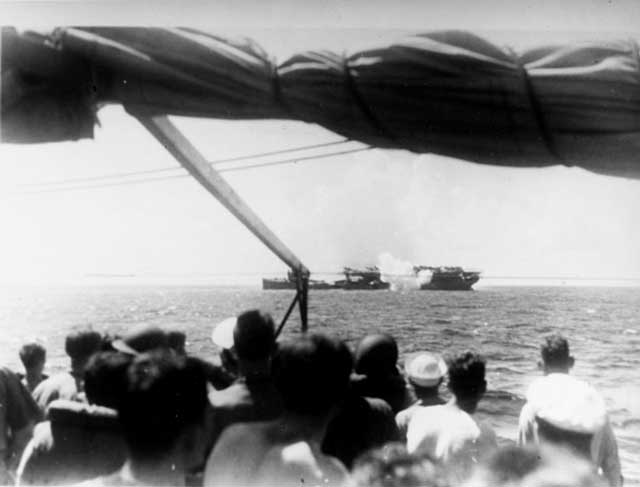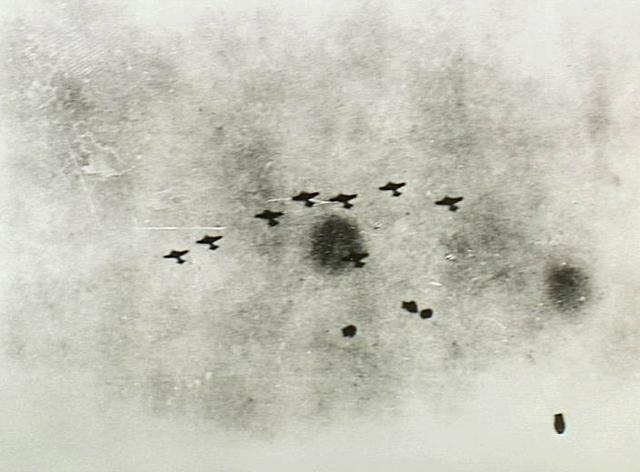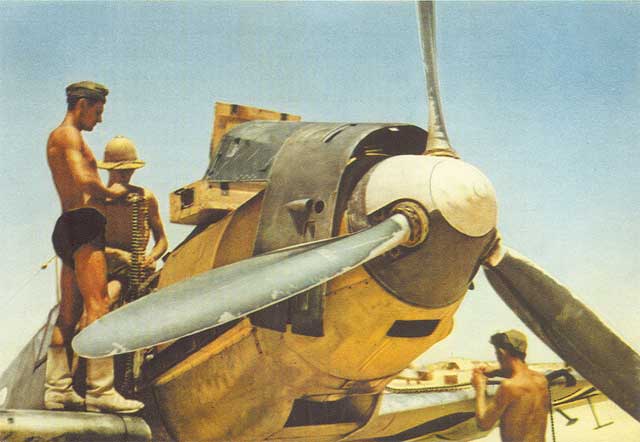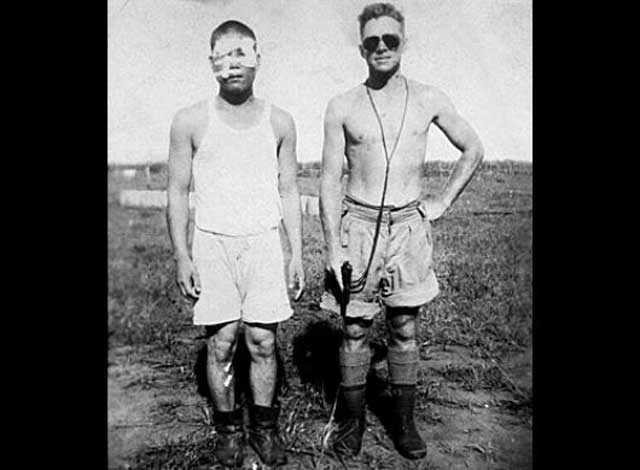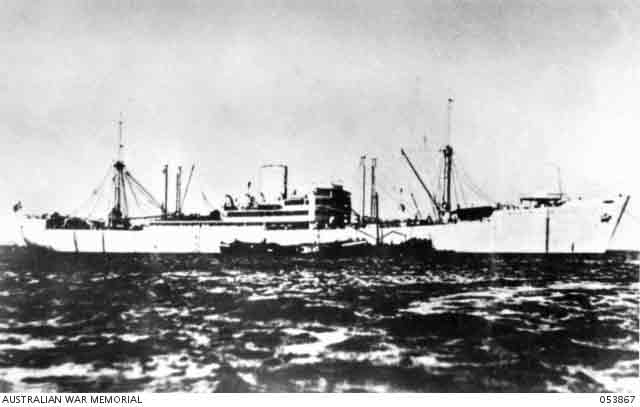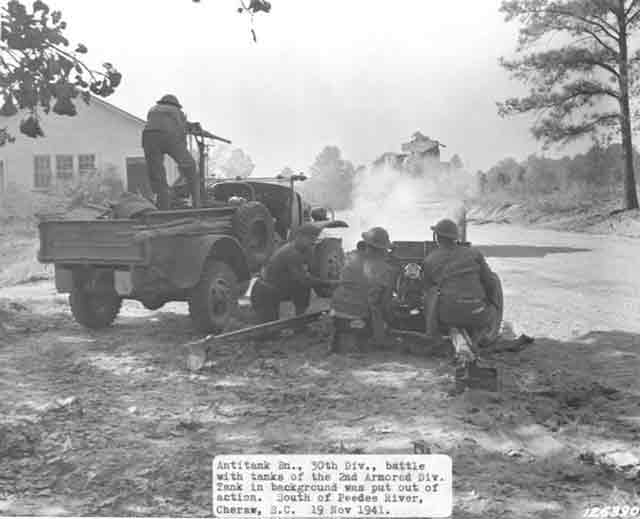Monday 26 May 1941
 |
| Battleship Bismark steering in circles after being hit by a torpedo in the stern, 26 May 1941. |
Anglo/Iraq War: A supply train filled with Syrian Vichy French military equipment arrives in Baghdad on
26 May 1941. These supplies include 8 155 mm artillery pieces, 6000 shells, 30,000 grenades, and 32 trucks.
The British take the Luftwaffe airfield at Mosul, with the Germans evacuating before they arrive. Reinforcements in the form of 11 Italian Fiat CR-42 fighters of Italian 155th Squadriglia arrive at Kirkuk during the day. The Italian fighters immediately attack the advancing British troops, who are in the Fallujah sector and approaching Baghdad. The British hope to capture Baghdad on the 27th.
European Air Operations: RAF Fighter Command undertakes Rhubarb raids over occupied France. RAF Bomber Command sends a dozen planes on anti-shipping operations. After dark, the RAF sends 38 bombers to drop mines off Brest in anticipation of the arrival of battleship Bismarck.
East African Campaign: There are media reports, such as in the Malaya Tribune, that 9,000 Italian troops have been captured in the Abyssinian Lake region. The reports state that Sudanese troops "captained by British officers" have rounded up the Italians, who had fled from Addis Ababa.
 |
| "The BISMARCK is seen in the distance from a Fairey Swordfish from the aircraft carrier HMS VICTORIOUS just before the torpedo attack, 26 May 1941." © IWM (A 9798). |
Battle of the Atlantic: The day begins with Bismarck steaming toward France at 20 knots. The British have not known where it is for 30 hours but has ships combing the North Atlantic for it. Thanks to Ultra, the Royal Navy knows that the Bismarck is heading for Brest, France, and has directed Force H from Gibraltar to conduct a search along the German ship's assumed course. However, the British are not the ones who locate it.
At 10:30 a patrolling US Catalina PBY flying boat (Ensign Leonard B. Smith of the US Navy) spots Bismarck about 690 nautical miles (790 miles, 1280 km) northwest of Brest. The British ships then turn to pursue the Bismarck. However, Bismarck now has a huge head start and just enough speed to make it to France if she can avoid being confronted before dark.
The British, though, have a trump card. Although it is badly needed in the Eastern Mediterranean to help protect Crete, Force H (Admiral James Somerville) is in position to attack Bismarck. Battleships HMS King George V and Rodney and aircraft carrier Ark Royal head to the northwest. Ark Royal launches its planes, and they spot a ship 60 nautical miles to the northwest. The planes, however, mistake Royal Navy cruiser Sheffield for the Bismarck and attack it with their torpedoes. Fortunately for the men of the Sheffield, the attack fails completely, and the Sheffield contacts the Ark Royal, which issues a recall order. However, at the same time, Bismarck fires at Sheffield, and shell fragments kill three crew and wound several others. This forces Sheffield to withdraw.
 |
| The identification of this photo is unclear, but it may be HMS Rodney during the hunt for German battleship Bismarck, 26 May 1941. |
The Ark Royal's planes rearm and refuel. Light already is beginning to fade, but Somerville takes a chance and orders another airstrike. Fifteen Swordfish take off at 19:10, with distance having narrowed to 40 nautical miles. The Swordfish make two hits. One is in the Bismarck's armored belt and causes some minor flooding that can be managed. The second, though, by RAF pilot John Moffatt, is serious. It hits the stern on the port side and causes major damage to both rudders. While the starboard rudder is made workable again, nothing can be done about the port rudder, which is hopelessly mangled and stuck at a bent angle. The Bismarck can only steam forward with a 12 degree turn to port, making it unmaneuverable.
So, the Bismarck is left unable to proceed further toward France. It is outside the range of Luftwaffe air cover, being just under 700 nautical miles from land, and there are no U-boats in the vicinity to protect it. The crew suggests dynamiting the rudder to restore maneuverability, but Vice-Admiral Günter Lütjens vetoes the suggestion because of the likelihood that an explosion in that vicinity would likely blow off the ship's propellers as well. (Underwater inspection after the ship's wreck is found shows that this would not have helped anyway).
The crew of the Bismarck thus is forced to remain in place throughout the night, with powerful Royal Navy forces approaching from all directions (battleship King George V is 130 miles behind but now closing rapidly). The Bismarck's men try to launch a floatplane in order to fly off the ship's log. However, it turns out that the catapult is damaged from the Battle of the Denmark Strait and the plane cannot be launched, so they push it over the side.
 |
| HMS Formidable under Luftwaffe attack, 26 May 1941. |
Knowing his ship is doomed, Lütjens at midnight signals headquarters with his final message:
Ship unmaneuverable. We shall fight to the last shell. Long live the Führer.
Just like the crew of Italian cruiser Fiume during the Battle of Cape Matapan in March 1941, the Bismarck's crew spends their last few hours of life contemplating their inevitable fate at the hands of the enemy.
Winston Churchill spends the day in the Admiralty War Room. He orders Admiral John Tovey aboard King George V to close on the Bismarck even if it means running out of fuel. In fact, cruiser Repulse has to pull out to refuel, but battleship Rodney takes its place. Around midnight, destroyers of Captain Philip Vian's 4th Flotilla approach Bismarck and launch torpedoes; whether any hit is unknown.
U-69 (Kptlt. Jost Metzler) completes its mission of laying seven mines in the port of Takoradi. It is a daring mission which includes cruising into the British port on the surface at night and brazenly unloading under the British guns.
The Luftwaffe bombs and damages 297-ton British freighter Gros Pierre off Sunderland. The master beaches the ship, and the Gros Pierre is later refloated and repaired.
The Luftwaffe bombs and damages 214-ton British trawler H.E. Stroud about 10 miles off Lamb Head, Stromsay. There is one death. The Stroud is taken under tow and taken to Kirkwall.
Royal Navy submarine H.31 runs aground at Lagan, but is freed and returns to Belfast for repairs.
Royal Navy minesweeper HMS Eastbourne (Lt. Commander Norman E. Morley) is commissioned.
Canadian minesweeper HMCS Bayfield is launched at North Vancouver, British Columbia.
Norwegian corvette KNM Andenes (ordered in 1939 and formerly designated as HMS Acanthus) is launched.
Free French corvette FS Commandant d'Estienne d'Orves (which has been redesignated from becoming HMS Lotus) is laid down.
Heavy cruiser USS Baltimore and destroyer Doyle are laid down.
 |
| HMS Formidable being bombed by the Luftwaffe, 26 May 1941. |
Battle of the Mediterranean: In Operation MAQ3, Royal Navy aircraft carrier HMS Formidable, escorted by a powerful force including battleships Barham and Queen Elizabeth, launches six Fairey Albacore planes around 02:00 to attack the Junkers Ju 87 Stuka airfield on Scarpanto. Due to mechanical issues, two planes return to the carrier, and the four remaining planes bomb their airfield between 05:05 and 05:15. Some Wellingtons from Malta arrive as planned at the same time and participate in the raid. Four Fairey Fulmars then arrive from Formidable and strafe the airfield around 05:45. The pilots report at least two aircraft destroyed on the ground, but also note 15 Junkers Ju 87 Stuka dive bomber and 15 Italian CR-42 fighters untouched by the attack.
As the British withdraw, the Stukas (led by II/StG2 led by Major Walter Enneccerus) hit the Formidable with two 1000 kg bombs, damaging it severely. In addition, destroyer Nubian is badly damaged by a Stuka and a Junkers Ju 88 but makes it back to port. There are a dozen deaths on the Formidable, with ten more wounded, and fifteen deaths on the Nubian, with six wounded. The Luftwaffe loses two Stukas. After fighting off further attacks, Formidable reaches Alexandria around dawn on the 27th.
 |
| HMS Formidable hit by bombs, 26 May 1941. |
On Crete, the Germans continue expanding eastward, pushing the Greek 1st Regiment defenders from Kastelli after a bitter three-day fight and approaching Canea (Chania), the island's capital. The Allies muddle through a troop changeover in front of the city which goes disastrously wrong, leading to the Germans surrounding the arriving 1000 Commonwealth troops. The Allied troops retreat to the east. The Luftwaffe mistakenly bombs the German troops advancing from Galatas toward Canea, aiding the Allies' retreat.
However, the pace of advance is slowing, and only so many troops can be brought in by air to Maleme airfield. Elsewhere on Crete, at Retimo and Heraklion, the German troops are barely hanging on in hopes of a quick advance from Maleme.
 |
| , 26 May 1941: a German Junkers Ju 52 transport takes off from Eleusis Airport outside Athens, bound for Crete. Below it is a line of French Vichy Air Force’s Dewoitine D 520s fighters. |
Despite the increasingly precarious British position, the Germans pessimistically conclude that it is beginning to look as if a long-term stalemate might develop. One of local air commander Wolfram von Richthofen's liaison officers returns from Crete today and reports that German morale is plummeting on the island. He states that there is an "absolute and critical need" for "reinforcement by sea shipment of heavy weaponry if the operation is to get ahead at all." The OKW thus contacts Italian Duce Mussolini and requests that he send Italian Army units. Mussolini agrees and begins preparations for a seaborne landing which would bring tanks.
The British, however, also are unhappy with the battle, and they try to reinforce the embattled troops there with multiple missions. The Royal Navy covers its bets by landing at Suda Bay about 800 men from No. 7 and No. 8 Commandos under the command of Colonel Robert Laycock, part of "Layforce." Their orders are to cover evacuation from the port, though it is still hoped that some portion of the island can be retained indefinitely. Another convoy containing reinforcements, led by commando ship Glenroy, comes under attack by the Luftwaffe and is forced to return to Alexandria. Convoy AN.3 of three Greek ships containing reinforcements also sets out from Alexandria today, but it also is forced to return to port as the situation on Crete deteriorates.
The problem for the British, however, is that the only way they can remain on the island is by holding ports on Crete's north shore, and already they are threatened. General Bernard Freyberg, the commander on Crete, becomes the first to broach the idea of an overall evacuation from the island in a message to Middle East Commander General Archibald Wavell, a proposal that is not acted upon at this time.
 |
| Damage to HMS Nubian from the bombing of 26 May 1941, after returning to Alexandria Harbor. Incredibly, despite the entire stern being blown off, the engines and propellers continued to function. |
At Kandanos and other hot spots on Crete, the Germans begin to develop a negative attitude toward the locals. The Germans have been taking heavy casualties despite their success, and they develop what may be characterized as a grudge against the local citizenry. Brutal repression is their response to those who oppose their rule.
The situation at sea off Crete is, if anything, deteriorating for the Royal Navy. A destroyer sweep off Milos must be canceled due to the Luftwaffe attacks on Formidable.
The Luftwaffe continues attacking the British-held ports on Crete. The Germans sink 145-ton Greek freighter Emmanuel Pteris at Candia Harbour and 6426 ton Greek freighter Rokos at Suda Bay.
On the Libyan border, Afrika Korps Commanding General Erwin Rommel prepares to launch Operation Skorpion. Colonel Maximilian von Herff, in command of Kampfgruppe von Herff, assembles his troops at the foot of Halfaya Pass, the operation's objective. The plan is to bluff the British into giving up the pass voluntarily by simulating an outflanking attack in force to the east. The attack is scheduled for the morning of the 27th.
Italian torpedo boats (Calliope, Circe, Clio, and Perseo) lay mines east of Malta.
An Italian supply convoy of six large freighters leaves Naples bound for Tripoli.
 |
| The Stuka attack on HMS Formidable, 26 May 1941. |
Battle of the Indian Ocean: Dutch gunboat Van Kinsbergen is operating east of Madagascar when it spots 8379 ton Vichy French freighter Winnipeg. The Dutch ship captures the Winnipeg.
Convoy BA.2 departs from Bombay, bound for Aden.
War Crimes:
Courts-martial are begun of military personnel aboard HMT Dunera, used to transport evacuees from England in the summer of 1940. The captain and others on the vessel are accused of malicious and predatory conduct, including but not limited to theft and savage beatings. The hearings are held at Chelsea Barracks, London, on 26th and 27th May 1941. This is an incident shrouded in some mystery and receives no press at the time. Specifically, the commanding officer, a regimental sergeant major, and a serjeant are put on trial.
Technically, these are not war crimes, as they do not involve enemy combatants. However, the actions of the British military personnel are alleged to have violated their military oaths and duties during wartime to the detriment of others, so this seems like the appropriate category. To be fair, the entire Holocaust could go in this category under the same reasoning, along with many other incidents, but I have a separate category entirely for the Holocaust due to its oppressive and ubiquitous nature.
Anglo/Irish Relations: Irish Prime Minister Éamon de Valera sends British Prime Minister Winston Churchill a
message about proposed British conscription in Northern Ireland:
Before your final decision is taken I feel that I should again put before your Government as earnestly as I can my view that the imposition of Conscription in any form would provoke the bitterest resentment amongst Irishmen and would have the most disastrous consequences for our two peoples.
Churchill very strongly feels that Ireland is not doing enough to help the war effort, but he takes this plea under earnest consideration.
 |
| A Fairey Fulmar hits the crash barrier while landing on HMS Formidable at 13:40 on 26 May 1941. |
Japanese Military: The Japanese Imperial Air Force make the first flight of the Kayaba Ka-1, Army Model 1 Observation Autogyro. It is closely based on the US Kellett KD-1A single-engine two-seat autogyro and has an observation platform for artillery spotting and is powered by a 240 hp (180 kW) Argus As 10c engine. The plane is useful because it is easy to maintain and has a short 98 foot (30 meters) take-off run.
 |
| Life Magazine, "Army Nurse" Catherine Mary Hines, 26 May 1941. |
British Government: Minister of Economic Warfare Hugh Dalton confides to his diary that there is a "general sense of gloom." After listing the various recent Royal Navy losses, Dalton comments:
Thus, says the PM [Churchill], the Germans have established a "unit superiority" over us. This is the most injurious and distressing naval incident [apparently referring to the Bismarck sinking the Hood] since we missed the Goeben [referring to a failed pursuit in the Mediterranean in 1914, when Churchill was First Lord of the Admiralty]. It is clear that these are Churchill's thoughts, not just Dalton's, considering the references.
Private Secretary Alexander Cadogan similarly notes in his diary that "Poor Winston very gloomy - due of course to Hood and Crete. In the latter place, things look black." He notes that there was "A tiresome and most acrimonious discussion" on a minor point about publicizing shipping losses, reflecting the tense nature of the evening War Cabinet meeting.
Foreign Secretary Anthony Eden, no doubt hearing of Churchill's "gloom," sends Churchill an inspirational (but odd) note:
This is a bad day; but tomorrow - Baghdad will be entered, Bismarck sunk. On some date the war will be won, and you will have done more than any man in history to win it.
Churchill does not respond.
 |
| On June 4, 1943, 381st Port Battalion Company "C" Scouts practice disembarking from a Landing Craft, Mechanized (LCM) in Newport News, Virginia. (Army Signal Corps Photograph/ Library of Virginia). This is a "Higgins Boat," designed by Andrew Jackson Higgins. It is the most recognizable landing craft of all time. The design passes its tests in Newport News 26 May 1941. |
US Military: Marine Commander Ross Daggett, from the Bureau of Ships, and Major Ernest Linsert, of the Marine Equipment Board, observe the testing of the three landing craft designed by businessman Andrew Higgins. The tests in Newport News, Virginia, involve off-loading a truck and embarking and disembarking 36 of Higgins' employees, simulating troops. The design passes the test and later is designated LCVP—Landing Craft Vehicle, Personnel.
German Military: Adolf Hitler holds a conference of tank experts at the Berghof, similar to the one he held there on 17 February 1941 when he ordered up-gunning of current tanks with 75 mm main guns (against Wehrmacht resistance that adding such guns would be excessive and impossible). Hitler today demands that 88 mm guns be used for future tanks, along with 100 mm frontal armor and 60 mm side armor. These are considered wildly excessive requirements at this time, but the demand will be met ultimately in the Tiger I and other heavy tanks. Once again, Hitler's orders will prove to be extremely prescient about future needs.
China: The Chinese lose 18 I-153s of the Chinese 29th Pursuit Squadron at Lanzhou. Eleven Japanese A6M Zeros of the 12th Kokutai attack Tienshui and Nancheng.
 |
| Bunker No. 8 in Hannover, Germany (Paul Moerenhout). |
German Homefront: In Hannover, Bunker No. 8 is ready for use. It's rated capacity is 698 people to shelter during air raids, but many more people will pack into it. Its construction is an indication of growing German realization that the war is going to last and air raids are not preventable. Bunker No. 8 remains intact as of this writing, a vivid reminder of World War II in the heart of Hannover.
American Homefront: New York Mayor Fiorella La Guardia's Office of Civilian Defense (OCD) conducts one of a series of air raid drills in the Northeast, this one a blackout in Newark, New Jersey.
The US Supreme Court of the United States decides United States v. Classic, 313 U.S. 299 (1941). It empowers (or affirms the right of) the US Congress to regulate primary elections and political nominations procedures. The "right of participation" is extended to primary elections. This is the first decision in a series that find that primaries are part of "two stages" of state and federal elections, both essential to the voting process and worthy of protection by appropriate laws.
The United Auto Workers (UAW) prepares to strike pursuant to a vote held on 24 May at the North American Aviation plant located at 5701 Imperial Highway in Inglewood, California. This is considered a key event in Los Angeles and US labor history.
 |
| Two Japanese A6M2 Zero fighters en route to attack Nanzheng, China, 26 May 1941. |
May 1941 May 1, 1941: British Hold TobrukMay 2, 1941: Anglo-Iraq WarMay 3, 1941: Liverpool HammeredMay 4, 1941: Hitler Victory SpeechMay 5, 1941: Patriots DayMay 6, 1941: Stalin In CommandMay 7, 1941: May BlitzMay 8, 1941: Pinguin SunkMay 9, 1941: U-110 CapturedMay 10, 1941: Hess Flies Into HistoryMay 11, 1941: The Hess Peace PlanMay 12, 1941: Tiger Arrives SafelyMay 13, 1941: Keitel's Illegal OrderMay 14, 1941: Holocaust in ParisMay 15, 1941: Operation BrevityMay 16, 1941: Blitz EndsMay 17, 1941: Habbaniya RelievedMay 18, 1941: Croatia PartitionedMay 19, 1941: Bismarck at SeaMay 20, 1941: Invasion of CreteMay 21, 1941: Robin Moore SinkingMay 22, 1941: Royal Navy Destruction Off CreteMay 23, 1941: Crete Must Be WonMay 24, 1941: Bismarck Sinks HoodMay 25, 1941: Lütjens' Brilliant ManeuverMay 26, 1941: Bismarck StoppedMay 27, 1941: Bismarck SunkMay 28, 1941: Crete LostMay 29, 1941: Royal Navy Mauled Off CreteMay 30, 1941: Sorge Warns, Stalin IgnoresMay 31, 1941: British Take Baghdad2020

